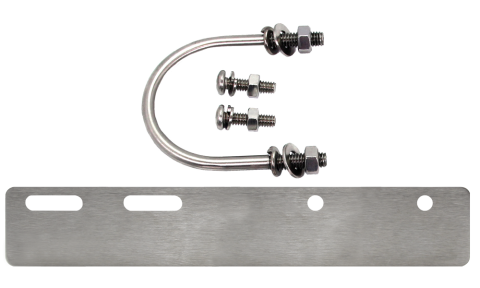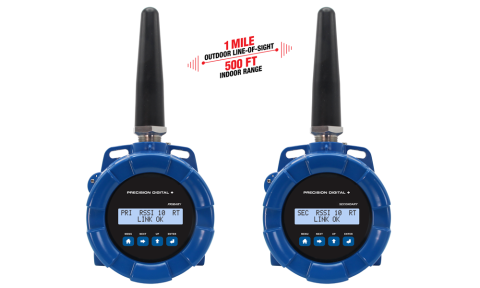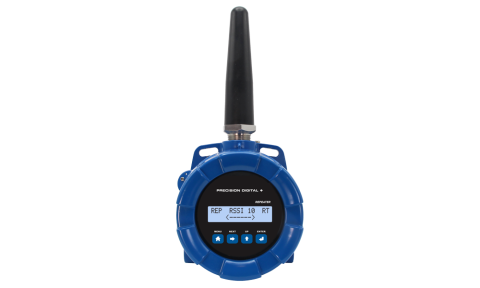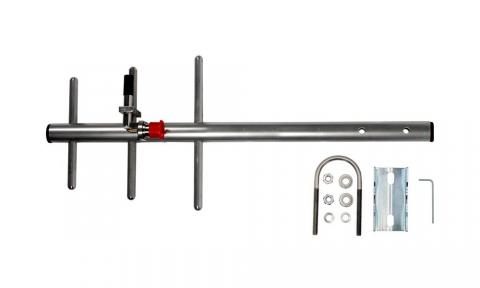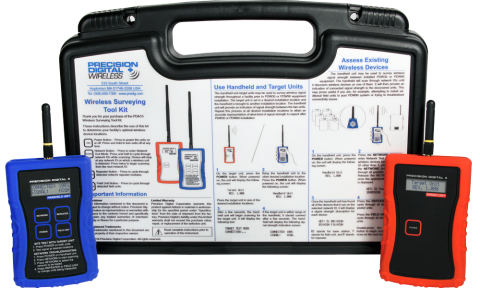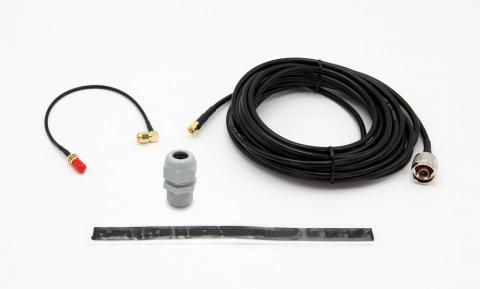PDW
- The PDWA6963-SS provides a convenient way to mount one PDW30 primary/secondary, PDWR repeater, or PDW90 field unit to a horizontal or vertical 1.5" or 2" pipe such that the antenna is not right on top of the metal pipe. The mounting kit is made from stainless steel and includes all necessary hardware to mount the PDW Field Unit to the pipe.
The Precision Digital PDW30 provides a simple, straightforward way to get an analog, discrete (digital) or Modbus signal from where you have it to where you need it – without having to run wires! It’s a point-to-point wireless bridge that is virtually plug and play right out of the box.
The PDW30 consists of a primary and a secondary unit and communication between the two is by-directional. That means you can send 4-20 mA, discrete and Modbus signals from the primary unit to the secondary unit and also send completely different 4-20 mA, discrete and Modbus signals from the secondary unit to the primary unit. For instance, the primary unit could send a 4-20 mA signal to the secondary unit corresponding to the level in a tank and the secondary unit could send a 4-20 mA signal to the primary unit to control a valve.
Primary and secondary units are also equipped with four digital I/O that can each be independently programmed as an input or an output. A Loss of Signal warning is also available by connecting devices to the G and LS screw terminals.
To indicate alarm situations, both units can be equipped with an optional, field installable, two relay module. These relays are rated Form A (SPST) 5A.
The specified range between the primary and secondary unit is 1 mile line-of-sight outdoor and 500 feet indoor and repeaters are available to extend the range. A low-cost wireless survey tool, Model PDA10, is available to test the signal strength of your application before you buy. And if the PDW30 system does not work in your application, you can return it for full credit!
In its most basic form, the PDW90 consists of field units (up to 32) that accept 4-20 mA signals and transmits them wirelessly to a base station. The primary advantage of this system is how simple and economical it is to get multiple signals (not just 4-20 mA, also discrete (digital) and Modbus) from where you have them to where you need them – all without having to run wires!
The wireless communication between the field units and the base station is bi-directional. That means you can send 4-20 mA, discrete and Modbus signals from the field units to the base station and also send completely different 4-20 mA, discrete and Modbus signals from the base station to the field units. For instance, the field unit could send a 4-20 mA signal to the base station corresponding to the level in a tank and the base station could send a 4-20 mA sig-nal to the field unit to control a valve.
Field units are also equipped with four digital I/O that can each be independently programmed as an input or an output. A Loss of Signal warning is also available by connecting devices to the G and LS screw terminals.
To indicate alarm situations in the field, the field unit can be equipped with an optional, field installable, two relays module. These relays are rated Form A (SPST) 5A and are controlled by the digital outputs on the base station.
The base stations are available in configurations for 2, 6, or 16 I/O slots for a variety of field installable I/O modules. The available I/O modules are:
- •Dual Analog Input
- •Dual Analog Output
- •Dual Relay Output
- •Four Digital I/O
The specified range between the base station and field units is 1 mile line-of-sight outdoor and 500 feet indoor and repeaters are available to extend the range. A low-cost wireless survey tool, Model PDA10, is available to test the signal strength of your application before you buy. And if the PDW90 system does not work in your application, you can return it for full credit!
PDWR wireless signal repeaters are used to improve the connectivity in PDW30 point to point and PDW90 point to multi-point wireless systems. They will generally increase signal range of the system by another 1 mile line-of-sight or 500 feet indoor.
The repeaters are simple to install as they only require power and a network ID. Any PDW wireless units in range of the repeater with the same network ID will retransmit through it, thus increasing signal strength.
PDWR repeaters can be used to broadcast over very long distances or around permanent obstacles.
The PDWR repeaters are available in either aluminum or stainless steel NEMA 4X, IP68 enclosures and these enclosures contain plenty of room for field wiring connections.
The PDWA3900 Yagi antennas are made to work with point-to-point and point to multi-point applications.
These high gain antennas are ideal to use with Precision Digital's PDW series because they give you the flexibility of installing the antenna exactly where you need to bridge your point-to-point or point to multi-point wireless process signals while keeping the PDW unit in a convenient location for monitoring.
Each Yagi antenna is factory tuned on a network analyzer for best power match and lowest VSWR, offering the best possible performance.
The PDWA3900 also comes complete with a mounting kit that includes stainless steel hardware.
Extension cable accessories are available to extend the distance between the Yagi antenna and the PDW30 or PDW90 wireless units. See Ordering Information for details.
The PDA10 is a wireless surveying tool kit which is intended to be used in conjunction with PDW30 or PDW90 wireless products. The surveying tool kit comes with two units: a handheld unit and a target unit. Use the pair prior to wireless system installation to demonstrate signal strength throughout the facility or between intended installation locations. The handheld unit may be used standalone after installation in order to determine received signal strength from all of the devices in order to determine new field unit locations or to troubleshoot connectivity issues.
The PDWA3100 extension cables are used to extend the distance between the Yagi Antenna and the PDW30 or PDW90 wireless units. The extension cables come in 20-foot and 40-foot lengths and include an antenna coupler to connect the PDW wireless device to the antenna extension cable, coax seal tape, and a 3/4" NPT cable gland.
Modules for the PDW90 base station are easy to install and add functionality to the wireless system. There are four types of modules available: dual analog inputs, dual analog outputs, digital I/O, and dual relays. The analog outputs module allows the base station to output two independent analog signals being broadcast by any of the field units. The analog inputs module allows the base station to accept two analog signals and transmit them wirelessly to any of the connected field units. The digital I/O module contains four channels which can be programmed to correspond with any of the field units’ digital inputs or outputs. The dual relays module can also be controlled from any of the connected field units’ digital I/O.


